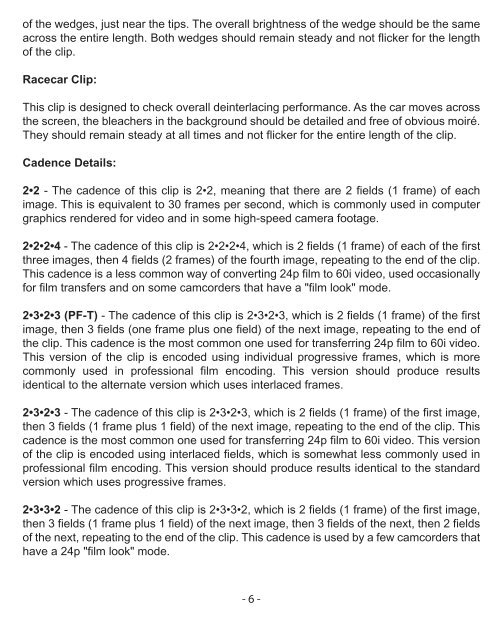You also want an ePaper? Increase the reach of your titles
YUMPU automatically turns print PDFs into web optimized ePapers that Google loves.
of the wedges, just near the tips. The overall brightness of the wedge should be the same<br />
across the entire length. Both wedges should remain steady and not flicker for the length<br />
of the clip.<br />
Racecar Clip:<br />
This clip is designed to check overall deinterlacing performance. As the car moves across<br />
the screen, the bleachers in the background should be detailed and free of obvious moiré.<br />
They should remain steady at all times and not flicker for the entire length of the clip.<br />
Cadence Details:<br />
2•2 - The cadence of this clip is 2•2, meaning that there are 2 fields (1 frame) of each<br />
image. This is equivalent to 30 frames per second, which is commonly used in computer<br />
graphics rendered for video and in some high-speed camera footage.<br />
2•2•2•4 - The cadence of this clip is 2•2•2•4, which is 2 fields (1 frame) of each of the first<br />
three images, then 4 fields (2 frames) of the fourth image, repeating to the end of the clip.<br />
This cadence is a less common way of converting 24p film to 60i video, used occasionally<br />
for film transfers and on some camcorders that have a "film look" mode.<br />
2•3•2•3 (PF-T) - The cadence of this clip is 2•3•2•3, which is 2 fields (1 frame) of the first<br />
image, then 3 fields (one frame plus one field) of the next image, repeating to the end of<br />
the clip. This cadence is the most common one used for transferring 24p film to 60i video.<br />
This version of the clip is encoded using individual progressive frames, which is more<br />
commonly used in professional film encoding. This version should produce results<br />
identical to the alternate version which uses interlaced frames.<br />
2•3•2•3 - The cadence of this clip is 2•3•2•3, which is 2 fields (1 frame) of the first image,<br />
then 3 fields (1 frame plus 1 field) of the next image, repeating to the end of the clip. This<br />
cadence is the most common one used for transferring 24p film to 60i video. This version<br />
of the clip is encoded using interlaced fields, which is somewhat less commonly used in<br />
professional film encoding. This version should produce results identical to the standard<br />
version which uses progressive frames.<br />
2•3•3•2 - The cadence of this clip is 2•3•3•2, which is 2 fields (1 frame) of the first image,<br />
then 3 fields (1 frame plus 1 field) of the next image, then 3 fields of the next, then 2 fields<br />
of the next, repeating to the end of the clip. This cadence is used by a few camcorders that<br />
have a 24p "film look" mode.<br />
- 6 -


